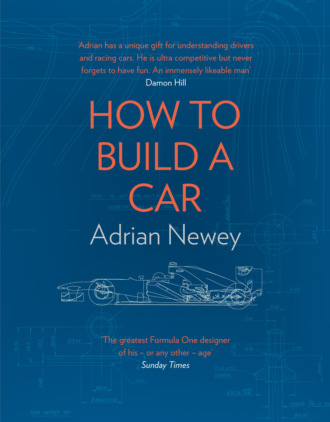
Полная версия
How to Build a Car
On this occasion her charms were wasted. ‘Indeed, this is about Adrian,’ she was told flatly. ‘But I’m afraid he hasn’t been a good boy. In fact, he has been a very bad boy. So bad, in fact, that I’m afraid you are going to have to take him away. He is no longer welcome at Repton.’
My mother looked from the headmaster to me and then back again. She raised her chin. ‘Well if that’s your attitude, Lloyd, I’ll have my plant back,’ she said. ‘Come on Adrian, let’s go.’
I know nothing about Jeremy’s expulsion, but that’s how I got my marching orders. I left Repton under a cloud, relieved to finally wave the place goodbye (flicking it the Vs at the same time).
I’ve been back since, mind you. Just the once, when my father and I competed in a ‘boys versus old Reptilians’ cross-country run. But other than that, it was a not-particularly-fond final farewell. The irony is that I am told photographs of Jeremy and me are among other noteworthy old Reptonians in their Hall of Fame.
CHAPTER 5
Post-Repton, life improved and things started to click into place: I finally raced the kart at Shenington, and though the kart and I didn’t exactly set the world alight, at least we could race towards the back of ‘the pack’, and were several seconds faster than we had been 12 months earlier.
By accident it turned out that the chopper blade I had made to go on the end of the crankshaft, to give the electronic ignition its signal to spark, happened to be of a width that meant it also gave about the right ignition timing if the engine ran backwards. And so the most notable feature of my race weekend was when I spun at the hairpin during practice and must have pressed the clutch while still going backwards. When I let the clutch back out I found I suddenly had four reverse gears instead of four forward! The look of disbelief from onlookers as I completed the rest of the lap into the paddock backwards, looking over my shoulder, still brings a smile to my face. The chief steward was less impressed with my efforts, however.
I also began work on a ‘special’, which was a road-going sports car that I planned to build from my own drawings. It was an ambitious project, and although it was one I ultimately abandoned, a couple of valuable things emerged from the experience. The first thing was that in the course of researching it, I read of a guy called Ian Reed of Delta Racing Cars in Surrey who’d built such a car, so – figuring he might be a useful source of information – I wrote to him.
One exchange of letters later and Ian invited me along to the factory, spent about half a day looking over my drawings, and gave me tips on how to develop and design the car, as well as a bit of useful careers advice.
Second, I was putting in the hours. Apparently, in order to attain expert status at any given activity, be it tennis, violin, cooking, whatever, you need to clock up at least 500 hours’ practice, ideally from the age of eight through your teens, when you’re much more receptive and can learn more quickly.
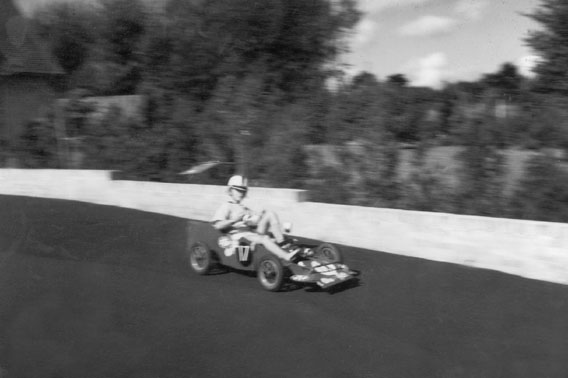
Me in my modified pedal go-kart.
Unknowingly, that’s exactly what I was doing. I was practising, just as I always had. For my combined eighth birthday-and-Christmas present (a dreaded combination familiar to anyone who has a birthday near Christmas), I’d received a pedal go-kart, and sure enough I customised it by adding on my own bodywork parts in order to make it look like a Formula One car. Later came my 10-speed Carlton bicycle that I lightened by drilling holes in it and swapping the supplied steel saddle post for my own aluminium design. I was very proud of that – until the day it snapped.
So even though my plans for ‘the special’ didn’t quite get off the ground, it was still a valuable exercise. And anyway, there’s only so much time you can spend in the workshop. The poor old special was competing with my new life of college, girlfriends and, most especially, as soon as I reached my seventeenth birthday, motorbikes.
For the first term at college I had cycled the three miles to the bus station in Stratford and then taken the bus to Leamington. Many of the guys on the course (about 15 of us in total, no girls) had Yamaha FS1E or Puch mopeds, while one of the guys, Andy, being slightly older, had a Norton Commando, making him supercool. Bikes were the main topic of interest between lessons and at lunch, and I immediately felt drawn. Luckily for me, it turned out my dad also had a passion for bikes, having ridden as a despatch rider in the army. Such was his enthusiasm, he offered to buy me a brand-new bike for Christmas/birthday (I guess that combo can come in handy sometimes), which left me very happy but somewhat dumbfounded at the time after the kart experience. Initially I fancied a Ducati 250 but then, reading Bike magazine, read a road test on a relatively new bike, a Moto Morini 350 Sport. My dad agreed and hence at exactly 17 I became the proud owner of one. Just one small problem: the law only allowed learners to ride bikes under 250cc. So for £25 I acquired a very tired 1958 BSA C15 to learn to ride and pass my test on, while my dad kindly took it upon himself to do around a thousand miles on the Morini to ‘run it in’.
The summer of 1976 was a wonderful long hot summer, perfect for my newfound love of riding motorbikes, despite the melted tar on the road that caught out so many of my mates. I became an enthusiastic member of the local bike club, Shakespeare’s Bikers, which met at The Cross Keys every Wednesday at seven, and enjoyed many weekend outings. Suddenly I had a new passion, a group of friends from all walks of life (through college and the bike club), and – thanks to this new network – an introduction to a social life that included girls. Added to these was the advent of punk, a welcome backlash from the slushy music of Donny Osmond et al. House parties featuring this new anarchic music allowed me to indulge in the only form of dancing I’m any good at – pogoing.
I loved my bike. There was a real camaraderie among us bikers, a feeling of freedom that a car simply does not bring to the same extent. There was even a brief period in which I thought my future should be as a bike designer, but in my heart of hearts I knew this was the flush of a new romance; I should stay true to my equally unlikely ambition of becoming a racing car designer.
My maternal grandmother, Kath, lived on gin and Martini – a habit inherited by my mother – and I was very fond of her, which made it doubly upsetting when gangrene took her leg, after which she seemingly lost the will to live and passed away in a nursing home a few months later, in the summer of 1977.
No, I was told by my parents, you can’t spend your grandmother’s inheritance on another motorbike. You should put it in the building society. And anyway, what’s wrong with the Moto Morino?
But I’d been close to Kath, so I insisted it’s what she would have wanted. Manipulative, I know. But who among us is above a bit of strategic emotional blackmail at times? It worked and I got what ‘we’ both wanted: a Ducati 900SS (registration number CNP 617S), which was a very smart bike for an 18-year-old.
I loved British-made cars, mainly Lotus, but when it came to bikes, I lived la dolce vita. During my OND course we visited the Triumph and Norton factories, and what struck us was their arrogant belief that they were still the best in the world. They were determined to carry on doing what they were doing, making the same old Commandos and Tridents, seemingly oblivious to the fact that the Italians were making more attractive and better-quality bikes, while the Japanese were also manufacturing better-quality bikes at far lower prices.
The Triumph factory in particular was a dirty, union-run relic of a bygone age. One detail that stayed with me was a room in which the distinctive Triumph pinstripe was applied to the petrol tank. A pot of gold paint sat in one corner of the room. On a table in the centre was a petrol tank, and somewhere between the two was a Triumph worker, an old boy clad in grey overalls. The paintbrush in his hand shook as he approached the tin, dipped and slowly returned to the petrol tank, splattering gold paint on the floor as he came.
We watched, agape, convinced we were about to witness an act of vandalism, but at the very last moment his hand steadied and with a flick of the wrist and a smooth flourish he applied a perfect gold pinstripe to the tank.
A second, younger man would lift the tank away and replace it with a new one as the old boy shambled back to the paint pot and the whole process began again. It was incredibly inefficient. You dread to think what the white-coated engineers of Suzuki and Kawasaki would have made of it. But it was also strikingly beautiful. No doubt there’s a metaphor in there somewhere.
Like many of their generation, my mum and dad were vehemently opposed to Japanese-made products. ‘Jap crap’, my dad called them. So it was inevitable that I’d be drawn towards Italian bikes. The trouble was I was too drawn towards them (and girls, music and booze), and I almost flunked my end-of-first-year exams. Ian Reed had told me that in order to make it in motorsport I’d need a degree, and there was no degree without my OND. After that, and for the first time in my life, I truly applied myself academically, as well as setting about finding a university.
One thing I learnt from almost flunking those exams was that distraction is the enemy of performance: I thought I was revising in the lead-up but in fact I was listening to music while reading notes. I learnt the words to ELO songs, not my material.
Of the unis I considered, Southampton was the one calling out to me. I knew from reading Autosport that the racing teams Brabham and March used the wind tunnel in Southampton to develop their cars, and I figured that being a Southampton student might give me a chance to ingratiate myself with them.
The course itself was Aeronautics and Astronautics, and I didn’t – and still don’t, really – have an interest in aircraft. By rights I should have been aiming for a mechanical engineering degree, and if I’d wanted to end up in the automotive industry working on production-line cars then that’s what I’d have done.
But I didn’t want a career in the automotive industry. I wanted a career in racing. My thinking was that an Aeronautics course would teach me aerodynamics and about the design of lightweight structures, about materials and control theory. I decided that because of that parallel technology with aircraft, and because of the lure of the wind tunnel, I’d aim for Southampton.
I worked hard to get into Southampton and I succeeded. But the problem was that even though I’d apparently got the highest OND mark in the country, the maths content of the course was the same maths I’d learnt at advanced Maths O-level. At Southampton, all the lecturers assumed that students were educated to A-level standard.
With engineering, and particularly aeronautical engineering, being so maths orientated, I was woefully out of my depth and struggling to keep up with the lecturers, who would simply skip through the derivations of equations, assuming we all knew what they considered to be the basics.
At weekends I studied. Not socialising, not tinkering with ‘the special’, not even gallivanting around on my motorbike, just trying to get myself up to snuff with my maths. But however hard I worked, I always seemed to be two steps behind everybody else. To make matters worse, I shared Halls with a bunch of ’ologist students who did nothing but party – not exactly the perfect environment for the kind of crash-course study I needed. By Christmas I was seriously thinking of throwing in the towel.
Finally, in desperation, I did two things: first, I returned to see Ian Reed, who by now was at March, a production racing car company making Formula One and Formula Two cars, a sizeable outfit by the standards of the day.
‘Look,’ said Ian, ‘if you want a job as a draughtsman then it’s yours, but you’ll only ever be a draughtsman. If you want to be a proper design engineer, you need to get your degree. What I suggest you do is get your head down and keep battling.’
Second, my tutor, the late Ken Burgin, who was always very supportive, noted that I was struggling and helped me with extra tutorials. In addition, he instilled in me the need to keep going. That was the mantra. Ken and Ian both said it: get your head down, Adrian; keep battling.
So I did. And although I never really caught up with the maths – to this day, it’s my Achilles’ heel – I did manage to overcome the problem by memorising mathematical derivations parrot fashion. Put simply, I never understood them, but I knew how to fake them. It hasn’t held me back in the long term and, in a perverse way, it instilled in me a determination that when the going gets tough you need to get your head down and find a way through it. I also formed the ability to really and truly concentrate when studying, which has certainly helped me in my career, though I have to admit, not socially. Particularly at race weekends I tend to suffer from tunnel vision, not seeing left or right, only what is right in front of me.
The second year at Southampton was a bit more interesting, geared as it was towards the more practical side of things, which was my strength. The lectures were no longer all about background theory; we started to learn about applied engineering as well as gearing up for what would prove to be my favourite element of the course: the final-year project.
Fate, luck and chance were also playing their part. I started at Southampton in 1977 and graduated in 1980. Those three years just happened to be a time of seismic change in Formula One.
Which is where it starts to get really interesting.
CHAPTER 6
To make a racing car accelerate and achieve a higher top speed you need more power, less weight and less aerodynamic drag. And if that sounds like a simple set of goals, it probably would be, if not for the troublesome mechanics of cornering. A light car is able to change direction quickly, but it’s a misconception that a heavier car offers more grip. Tyres behave in a non-linear way, which means that if the load on the tyres is doubled during cornering they don’t offer twice the cornering force. To corner at the same speed, a car that weighs twice as much would need twice the grip and would accelerate more slowly.
This is where downforce comes in. Downforce is what we call the pressure that pushes the car downwards, effectively suckering it to the track. And because the generation of downforce is something that happens as a result of the aerodynamic shaping of the car, you can increase grip without it involving a significant increase in weight. In other words, you get to have your cake and eat it: more grip without a loss of acceleration.
Thus, the aim of the chassis designer is to:
One: ensure that the tyres are presented to the ground in an even and consistent manner through the braking, cornering and acceleration phases.
Two: ensure the car is as light as possible.
Three: ensure that the car generates as little drag as possible.
Four: ensure that the car is generating as much downforce as possible in a balanced manner throughout the phases of the corner.
Downforce was a still relatively poorly researched area in motorsport in 1977. Having sat out the 1940s and 1950s altogether, it then played a small part in the 1960s when teams began fitting spoilers to sports cars, typically at Le Mans where the inherent lift of the cars’ body shapes had led to drivers complaining of instability on the long, fast straights and kinks of that circuit. With the introduction of a very large rear wing by Jim Hall of Chaparral in 1967, cars started generating significant downforce for the first time, having literally looked to the skies for inspiration – to aircraft.
An aeroplane lifts because the contours of its wing cause air to flow at different speeds across the two sides, low pressure on the topside, high on the other, with the wing moving in the direction of the low pressure and giving us what we call ‘positive lift’ as a result.
The wing on a racing car works the same way, but in reverse: ‘negative lift’, or ‘downforce’, pressing the car into the ground and hence allowing the tyres to generate more grip.
With this blindingly simple solution established, wings on racing cars became a common feature of the 1970s, with teams continually seeking to create more downforce, but with little further progress, until 1977.
To explain what happened in 1977, please first allow me to offer a brief lesson in aerodynamics. The pressure difference across the surface of the wing creates a distortion of the flow field as it passes through the air, known as circulation. In the case of a racing car, this means that air behind the car is thrown upwards, creating a rooster tail of air behind the car that can clearly be seen when Formula One cars run in the wet. However, the air on the high-pressure side of the wing is also able to leak around the tips of the wing, reducing the low pressure on the suction side and hence reducing the wing’s efficiency. This tip leakage, when combined with the forward motion of the vehicle, sets up a spiral, tornado-like structure known as the tip vortex. These tip vortices can be seen spilling from the rear wing when a Formula One car runs on a damp day or indeed on the wings of aircraft as they come in to land in the same conditions.
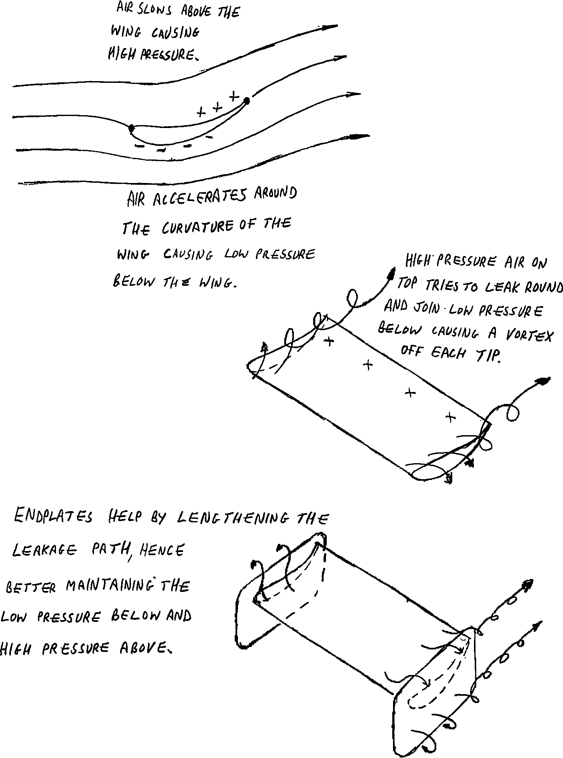
Figure 2: How a wing works and how it forms a vortex at its tips.
Aircraft (and birds) reduce this loss of efficiency of their wings by increasing span, exemplified by sailplanes, which have very long slender wings. However, in 1968, following a spate of accidents in Formula One caused by the long span, high wings used during the period collapsing, regulations were introduced to restrict their span. Teams responded by fitting plates to the ends of their chopped-down wings, which helped to create a more tortuous leak path between the upper and lower surfaces of the wing, but overall efficiency was reduced. This, simplistically, remained state-of-the-art technology in Formula One from 1968 to 1977.
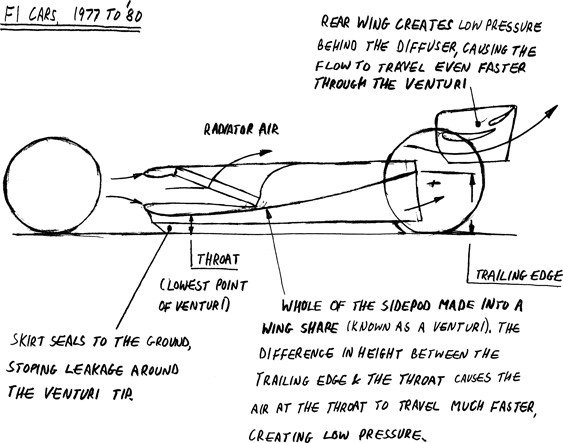
Figure 3: Making the sidepods of the car into a huge wing.
But nature, as is so often the case, had already worked out an efficient solution to the problem of how to make a wing of a given span much more efficient. If you watch a heavy river bird such as a swan, it will often fly just above the water, with the tips of its wings on the edge of dipping in. In doing so, it harnesses two powerful effects:
(1) If its wing tips just touch the water’s surface, the leak path is sealed, the low pressure on the suction surface is not compromised and the wing hence becomes much more efficient.
(2) The downwash of air behind the wing (created by circulation) reacts against the river’s surface, creating a higher pressure underneath the wing – a phenomenon known as ‘ground effect’.
Turn this upside down, so that you have a downforce-generating wing with its endplate rubbing on the ground, and suddenly you have a massively effective solution. This is exactly what Lotus did in 1977, using much of the underside of the car to create an enormous wing, sealed to the ground at its tips by ‘sliding skirts’.
It was an innovation that today we’d call a ‘disruptive technology’, a game-changer that pushed aerodynamics firmly to the forefront of racing car design.
Which is where I come in, because while all this was happening in the late 1970s, I was at university studying aerodynamics and hoping for a career in Formula One – a sport that had suddenly recognised the importance of aerodynamics.
You have to remember that at this time, racing teams were quite small – a staff of around 30 compared to the 800 or so we have at Red Bull today – and designers were mainly mechanical engineers; very few had studied aeronautics. They were trying to teach themselves, and, as such, development was somewhat haphazard.
It’s not a criticism. Far from it. If I could go back to design at any point in the sport’s history, it would be then, because if you look at the cars on the grid from the early to late 1970s, they all looked very different to each other. The rulebook then was small; they had a huge amount of freedom, but relatively little understanding of the end product, purely because they didn’t have the research tools that we benefit from today; they were only just waking up to the possibilities of wind tunnels and the kind of simulation tools we now use routinely.
But they were pioneers. They’d be trying new suspension geometries, ‘anti-dive’, ‘anti-lift’ or adaptable suspension that ended up flexing like bits of chocolate. Great ideas that somebody came up with in the shower or standing at their drawing board staring off into space. All of them released to great fanfare and acclaim. Most of them abandoned almost immediately. Giddy times.
Of all these early pioneers, the most buccaneering was Colin Chapman, founder and boss at Lotus and the closest thing I have to a design hero.
Chapman was one of the few who did in fact have aeronautical training, which he used to great effect. He had a tendency, though, to start afresh rather than build on past success, so having won the championship with a car powered by a Cosworth DFV engine in 1968 – the first car to feature that engine – Colin then decided to invest heavily in four-wheel drive, a lame duck of an idea that resulted in cars that were way too heavy to be competitive.
Another blind alley in the form of an inefficient gas turbine car meant that by 1970 Lotus were still racing the same car that had won the 1968 championship and were struggling to catch up. The Lotus 72 of mid-1970 was a gem that held them high through to 1972, followed by a further series of blind alleys. It wasn’t until the Lotus 78, the ground-effect car, that they became competitive again. And though they didn’t win the championship that year, the following year’s car, the Lotus 79, dominated 1978.
After that, however, Lotus returned to blind alleys. When Gordon Murray of Brabham introduced pullrod suspension to replace the old rocker system, and John Barnard at McLaren replied with a pushrod set-up – both of which helped cars cope with the huge loads generated by downforce – the Lotus answer was to develop a chassis with a separate aerodynamic shell linked directly to the wheels, so it transmitted all its downforce straight to the wheels, not through the suspension. It didn’t really work and, to add insult to injury, it was banned.
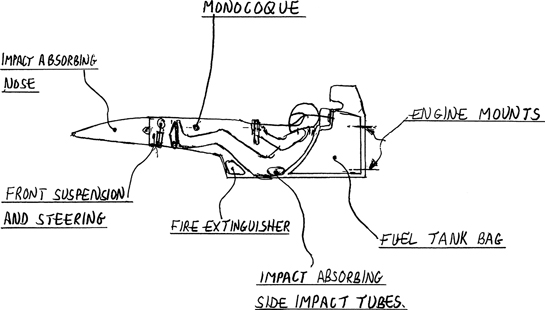
Figure 4: The monocoque with its many components.
Personally, I would have been intrigued to meet Chapman. He was a fascinating character, a real innovator. It was he who espoused the idea that high power was less important than good handling. He had a talent for applying advances made in disciplines other than F1. So, for example, he’s often credited as being the first to introduce monocoque construction, where instead of constructing a chassis from steel tubes, you make it out of sheets of aluminium. It was a revolution in Formula One, but the Jaguar D-type of 1954 was the car that had really introduced this construction technique to motor racing. Same with bolting the engine straight to the chassis instead of to a sub-frame.
Sadly, the ground-effect car was Chapman’s last hurrah. Not long afterwards, he teamed up with John DeLorean to design the DeLorean, the Back to the Future car, after which there were allegations of murky dealings, which were followed soon afterwards by an upcoming court case and an untimely fatal heart attack in 1982, when Chapman was aged just 54.
Mario Andretti, the driver of the ground-effect car during that championship-winning season, always maintained that Chapman had faked his own death and fled to Brazil in order to escape trial, a claim that would be absurd if it were anybody else but Chapman.
Meanwhile, back at Southampton University, I noticed that even though all the Formula One teams had cottoned on to the benefits of ground effect (marking the end of the era of crazy ideas in the shower and the beginning of a time when the design of cars began to converge into a generic shape), sports cars were lagging behind.




